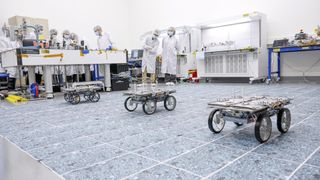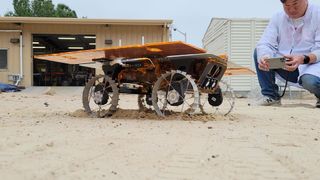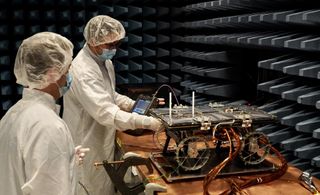
Engineers prepare three small Moon-bound rovers for a drive test in a clean room at the agency’s Jet Propulsion Laboratory in Southern California in December 2023. Along with a base station that will be mounted on a lunar lander, the rovers make up the CADRE (Cooperative Autonomous Distributed Robotic Exploration) technology demonstration. (Image credit: NASA/JPL-Caltech)
NASA test drove the mini autonomous rovers that will soon fly to the moon and collectively map the lunar surface.
The rovers are part of a technology demonstration called Cooperative Autonomous Distributed Robotic Exploration (CADRE), which is designed to show that a group of robotic spacecraft can work together without direct human control. NASA took the suitcase-sized rovers for a test drive across Mars Yard at the agency’s Jet Propulsion Laboratory (JPL) to simulate the rugged terrain they’ll experience on the moon.
A series of tests, performed in August 2023 using two full-scale development models while the spacecraft were still under construction, confirmed the mini CADRE rovers were able to drive in unison and adjust their coordinated path to avoid obstacles, according to a statement from NASA.
Related: Trio of mini moon rovers pass key tests ahead of upcoming lunar launch (photos)
The moon-bound rovers will be powered by solar panels and equipped with cameras, sensors and ground-penetrating radar to map the lunar surface in 3D. During the August 2023 test drive, only one of the rover models was fitted with a stand-in for solar panels. The other two were able to read one another’s battery levels to determine when a break was needed to recharge their solar arrays before continuing their trek together.
Additional tests included night drives at Mars Yard under large flood lamps to simulate the extreme shadows and lighting that the rovers will encounter during the lunar daytime, NASA officials said in a statement this month.

Following the Mars Yard tests, the rovers underwent vibration and thermal tests in November 2023 to ensure their hardware could survive the trip to the moon. A rover was clamped to a special “shaker table” that vibrates intensely in different directions. It was also placed in a thermal vacuum chamber that simulates the airless conditions of space and its extreme hot and cold temperatures.
The team also performed electromagnetic interference and compatibility testing in November 2023 in a specialized chamber designed to absorb radio waves. This confirmed that the rovers’ electronic subsystems did not interfere with each other nor with those on the lander, and that the rover can survive expected electromagnetic disturbances, according to NASA.

In early March, NASA announced that construction and testing of the three CADRE rovers was complete and the trio was ready for integration with Intuitive Machines’ Nova-C lander, which will deliver the mini explorers to the lunar surface later this year or early next year as part of the company’s third lunar lander mission, IM-3.
The rovers will explore the moon’s Reiner Gamma region, where they will spend the daylight hours of a lunar day, or the equivalent of about 14 days on Earth, and work together to study the lunar surface.

